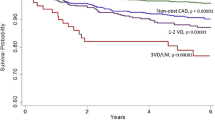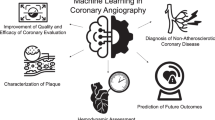Abstract
Purpose of review
To provide an update and to outline the status of coronary computer tomography angiography (CCTA) in the evaluation of coronary plaques and discuss the relevance of serial CCTA in guiding cardiovascular risk stratification and anti-atherosclerotic medical therapy.
Recent findings
Coronary CTA is now the imaging modality of choice in monitoring changes in coronary plaque. It has been used in innumerable clinical trials which have demonstrated the benefits of several therapeutic agents and has excellent correlation with previously used invasive imaging modalities. It is safe, fast, less cumbersome, and a cost-effective testing method compared to other invasive imaging modalities for coronary plaque analysis.
Summary
The emergence of a noninvasive imaging modality such as CCTA now permits quantification not only of plaque burden but also allows for further distinction of plaque components and identification of vulnerable plaques. The application of these findings continues to extend the prospect of coronary CTA in evaluation and management of atherosclerotic coronary artery disease (CAD) in clinical practice. In the future, artificial intelligence and machine learning will play a significant role in plaque analysis allowing for high accuracy and reproducibility which will lead to a substantial increase in the utilization of coronary CTA.
Similar content being viewed by others
Abbreviations
- TP :
-
Total plaque
- NCP :
-
Non-calcified plaque
- CP :
-
Calcified plaque
- DCPV :
-
Dense calcified plaque
- LAP :
-
Low-attenuation plaque
- LRNC :
-
Lipid-rich necrotic core
- PAV :
-
Percent atheroma volume
- TAV :
-
Total atheroma volume
- HRP :
-
High-risk plaque
References
Papers of particular interest, published recently, have been highlighted as: • Of importance •• Of major importance
Roth GA, et al. Global burden of cardiovascular diseases and risk factors, 1990–2019: Update From the GBD 2019 Study. J Am Coll Cardiol. 2020;76(25):2982–3021.
Hoffmann U, et al. Noninvasive assessment of plaque morphology and composition in culprit and stable lesions in acute coronary syndrome and stable lesions in stable angina by multidetector computed tomography. J Am Coll Cardiol. 2006;47(8):1655–62.
Otsuka K, et al. Napkin-ring sign on coronary CT angiography for the prediction of acute coronary syndrome. JACC: Cardiovascular Imaging, 2013. 6(4): p. 448–457.
Williams MC, et al. Low-attenuation noncalcified plaque on coronary computed tomography angiography predicts myocardial infarction. Circulation, 2020. 141(18): p. 1452–1462. An important paper demonstrating the predictive value of low-attenuation plaque in a large prospective study, SCOT-HEART.
Taron J, et al. Risk stratification with the use of coronary computed tomographic angiography in patients with nonobstructive coronary artery disease. JACC Cardiovasc Imaging, 2021.
Boden WE, et al. Optimal medical therapy with or without PCI for stable coronary disease. N Engl J Med. 2007;356(15):1503–16.
A randomized trial of therapies for type 2 diabetes and coronary artery disease. New England J Med, 2009. 360(24): p. 2503–2515.
Maron DJ, et al. Initial invasive or conservative strategy for stable coronary disease. New England J Med, 2020. 382(15): p. 1395–1407. The ISCHEMIA Trial, demonstrating that functional ischemia testing, such as nuclear imaging, does not allow for valuable stratification to coronary intervention.
Naoum C, et al. Predictive value of age- and sex-specific nomograms of global plaque burden on coronary computed tomography angiography for major cardiac events. Circ Cardiovasc Imaging, 2017. 10(3).
Cho YK, et al. Usefulness of baseline statin therapy in non-obstructive coronary artery disease by coronary computed tomographic angiography: From the CONFIRM (COronary CT Angiography EvaluatioN For Clinical Outcomes: An InteRnational Multicenter) study. PLoS One, 2018. 13(12): p. e0207194.
Lewis MA, et al. Selecting a CT scanner for cardiac imaging: the heart of the matter. Br J Radiol. 2016;89(1065):20160376–20160376.
Hetterich H, et al. AHA classification of coronary and carotid atherosclerotic plaques by grating-based phase-contrast computed tomography. Eur Radiol. 2016;26(9):3223–33.
Glagov S, et al. Compensatory enlargement of human atherosclerotic coronary arteries. N Engl J Med. 1987;316(22):1371–5.
Narula J, et al. Histopathologic characteristics of atherosclerotic coronary disease and implications of the findings for the invasive and noninvasive detection of vulnerable plaques. J Am Coll Cardiol. 2013;61(10):1041–51.
Yokoya K, et al. Process of progression of coronary artery lesions from mild or moderate stenosis to moderate or severe stenosis. Circulation. 1999;100(9):903–9.
Motoyama S, et al. Computed tomographic angiography characteristics of atherosclerotic plaques subsequently resulting in acute coronary syndrome. J Am Coll Cardiol. 2009;54(1):49–57.
Motoyama S, et al. Plaque characterization by coronary computed tomography angiography and the likelihood of acute coronary events in mid-term follow-up. J Am Coll Cardiol. 2015;66(4):337–46.
Ahmadi A, et al. Lesion-specific and vessel-related determinants of fractional flow reserve beyond coronary artery stenosis. JACC. 2018;11(4): p. 521–530.
Ferencik M, et al. Use of high-risk coronary atherosclerotic plaque detection for risk stratification of patients with stable chest pain: a secondary analysis of the PROMISE randomized clinical trial. JAMA Cardiol, 2018. 3(2): p. 144–152. Important study showing coronary plaque on CTA is important for risk stratification of chest pain patients.
Coronary CT. angiography and 5-year risk of myocardial infarction. N Engl J Med. 2018;379(10):924–33.
Williams MC, et al. Coronary artery plaque characteristics associated with adverse outcomes in the SCOT-HEART study. J Am Coll Cardiol. 2019;73(3):291–301.
Scandinavian Simvastatin Survival Study, G., Randomised trial of cholesterol lowering in 4444 patients with coronary heart disease: the Scandinavian Simvastatin Survival Study (4S). Lancet. 1994; 344(8934): p. 1383–1389.
Waters DD, et al. Treating to New Targets (TNT) Study: does lowering low-density lipoprotein cholesterol levels below currently recommended guidelines yield incremental clinical benefit? Am J Cardiol. 2004;93(2):154–8.
Lee SE, et al. Effects of statins on coronary atherosclerotic plaques: The PARADIGM Study. JACC Cardiovasc Imag. 2018;11(10): 1475–1484. Large prospective multinational study demonstrating the slower progression of plaque volume due to the effect of statins compared to no statin.
Otaki Y, et al. Decrease in LDL-C is associated with decrease in all components of noncalcified plaque on coronary CTA. Atherosclerosis. 2019;285:128–34.
Hoffmann U, et al. Rationale and design of the mechanistic substudy of the randomized trial to prevent vascular events in HIV (REPRIEVE): effects of pitavastatin on coronary artery disease and inflammatory biomarkers. Am Heart J. 2019;212:1–12.
Vaidya K, et al. Colchicine therapy and plaque stabilization in patients with acute coronary syndrome. JACC: Cardiovasc Imag, 2018. 11(2_Part_2):305–316.
Lee DH, et al. Effect of cilostazol, a phosphodiesterase-3 inhibitor, on coronary artery stenosis and plaque characteristics in patients with type 2 diabetes: ESCAPE study. Diabetes Obes Metab. 2019;21(6):1409–18.
Elango K, et al. The effects of warfarin and direct oral anticoagulants on systemic vascular calcification: a review. Cells, 2021. 10(4).
Plank F, et al. Influence of vitamin K antagonists and direct oral anticoagulation on coronary artery disease: a CTA analysis. Int J Cardiol. 2018;260:11–5.
Win TT, et al. Apixaban versus warfarin in evaluation of progression of atherosclerotic and calcified plaques (prospective randomized trial). Am Heart J. 2019;212:129–33.
Elnabawi YA, et al. Coronary artery plaque characteristics and treatment with biologic therapy in severe psoriasis: results from a prospective observational study. Cardiovasc Res. 2019;115(4):721–8.
Choi H, et al. Treatment of psoriasis with biologic therapy is associated with improvement of coronary artery plaque lipid-rich necrotic core. Circulation: Cardiovasc Imag. 2020;13(9):e011199.
Karpouzas GA, et al. Biologics may prevent cardiovascular events in rheumatoid arthritis by inhibiting coronary plaque formation and stabilizing high-risk lesions. Arthritis & Rheumatology. 2020;72(9):1467–75.
Ried K. Garlic lowers blood pressure in hypertensive subjects, improves arterial stiffness and gut microbiota: a review and meta-analysis. Exp Ther Med. 2020;19(2):1472–8.
Shabani E, Sayemiri K, Mohammadpour M. The effect of garlic on lipid profile and glucose parameters in diabetic patients: a systematic review and meta-analysis. Prim Care Diabetes. 2019;13(1):28–42.
Munday JS, et al. Daily supplementation with aged garlic extract, but not raw garlic, protects low density lipoprotein against in vitro oxidation. Atherosclerosis. 1999;143(2):399–404.
Shaikh K, et al. Aged garlic extract reduces low attenuation plaque in coronary arteries of patients with diabetes: a randomized, double-blind, placebo-controlled study. Exp Ther Med. 2020;19(2):1457–61.
Budoff MJ, et al. Effect of icosapent ethyl on progression of coronary atherosclerosis in patients with elevated triglycerides on statin therapy: final results of the EVAPORATE trial. Eur Heart J. 2020;41(40):3925–3932. Randomized trial showing plaque regression under the influence of icosapent ethyl compared to placebo.
Motoyama S, et al. Effect of omega-3 fatty acids on coronary plaque morphology - a serial computed tomography angiography study. Circ J, 2021.
Kita Y, et al. Effects of fatty acid therapy in addition to strong statin on coronary plaques in acute coronary syndrome: an pptical coherence tomography study. J Am Heart Assoc. 2020;9(16):e015593.
Niki T, et al. Effects of the addition of eicosapentaenoic acid to strong statin therapy on inflammatory cytokines and coronary plaque components assessed by integrated backscatter intravascular ultrasound. Circ J. 2016;80(2):450–60.
Bhatt DL, et al. Cardiovascular risk reduction with icosapent ethyl for hypertriglyceridemia. N Engl J Med. 2018;380(1):11–22.
Hirai K, et al. Effect of evolocumab on vulnerable coronary plaques: a serial coronary computed tomography angiography study. J Clin Med. 2020;9(10).
Henzel J, et al. High-risk coronary plaque regression after intensive lifestyle intervention in nonobstructive coronary disease: a randomized study. JACC Cardiovasc Imaging, 2021;14(6):1192–1202. Randomized controleld trial showing the effect of diet and exercise on plaque volume progression.
Lu B, et al. Effects of scanning and reconstruction parameters on image quality in electron-beam CT angiography: coronary artery phantom study. Acad Radiol. 2000;7(11):927–33.
Budoff MJ, et al. Task Force 12: training in advanced cardiovascular imaging (computed tomography): endorsed by the American Society of Nuclear Cardiology, Society for Cardiovascular Angiography and Interventions, Society of Atherosclerosis Imaging and Prevention, and Society of Cardiovascular Computed Tomography. J Am Coll Cardiol. 2006;47(4):915–20.
Hamal S, et al. Effect of semaglutide on coronary atherosclerosis progression in patients with type II diabetes: rationale and design of the semaglutide treatment on coronary progression trial. Coron Artery Dis. 2020;31(3):306–14.
Funding
Matthew J Budoff receives research support from General Electric (GE) and funding support from the National Institutes of Health (NIH). Venkat S. Manubolu and Sion K. Roy declare that they have no financial interests to disclose.
Author information
Authors and Affiliations
Contributions
Dr. Matthew Budoff conceived of the article idea. All authors were involved in the literature search. The first draft of the manuscript was written by Venkat S. Manubolu, and all authors assisted with edits of the manuscript. All authors read and approved the final manuscript.
Corresponding author
Ethics declarations
Competing Interests
The authors declare no competing interests.
Ethics Approval
N/A
Consent to Participate
N/A
Consent to Publish
N/A
Additional information
Publisher's Note
Springer Nature remains neutral with regard to jurisdictional claims in published maps and institutional affiliations.
This article is part of the Topical Collection on Cardiac Computed Tomography
Rights and permissions
About this article
Cite this article
Manubolu, V.S., Roy, S.K. & Budoff, M.J. Prognostic Value of Serial Coronary CT Angiography in Atherosclerotic Plaque Modification: What Have We Learnt?. Curr Cardiovasc Imaging Rep 15, 1–10 (2022). https://doi.org/10.1007/s12410-022-09564-y
Accepted:
Published:
Issue Date:
DOI: https://doi.org/10.1007/s12410-022-09564-y




